If the IT world were a planet, it would probably be surrounded by a belt of buzzwords. Digital transformation, hyper-automation, extended reality, 5G, artificial intelligence, enhanced connectivity, and the list goes on.
Don’t get me wrong. I’m not saying that these matters aren’t important, no. But too often, IT executives corner themselves with those trendy terms without grasping the meaning behind them. As Matt Clair, CIO of Clair Global, nicely put it: “In our world, everyone is talking about 5G, but 90% of them don’t know what they’re talking about.”
If you ever googled what the priorities for technology leaders are, you must’ve seen lists filled with those buzzwords. Sounds progressive, even innovative, but not necessarily relevant or useful.
As we move past the one-year mark since the start of the COVID-19 pandemic with its cruel but valuable lessons, many IT leaders start to reframe their role in the business and re-evaluate their priorities.
The crisis has helped tech leaders cut off the buzz and focus on the things that matter the most — business continuity and customer/employee experience. As a result, 61% out of 4200 CIOs surveyed by Harvey Nash in late 2020 say they feel more influential than ever before.
So, what are the top priorities for CIOs right now? I reached out to eight brilliant IT leaders to get the insights first-hand. Without further ado, let’s dive into it!
Bridging the Digital Divide
The COVID-19 crisis has exposed the great digital divide. According to the KPMG CIO survey, 70% of organizations did not have the infrastructure needed to deal with the pandemic reality at the beginning of 2020. Those 3 in 10 IT leaders who strategically embraced digital transformation early enough got an advantage over those who had to adapt on the go to the challenges imposed by the crisis.
Some may see this as a disadvantage, but what it really means is a unique opportunity. Distinguished Fellow & Chief Innovation & Data Officer (CIDO) at Avasant Renée B. Lahti says information technology leadership should embrace this “Business as UN-usual” and use the momentum to bridge the digital divide.
“Acknowledge the gift of the mandatory Digital Transformation (DX) that has occurred as a result of the global pandemic, and don’t waste it. Rapid mandated DX would have never been possible otherwise — exploit for the betterment of your organization,” says Lahti.
Renée illustrates this point with a recent panel discussion she hosted. “The CIO of a very old and well-respected university put it best,” she says. “He indicated that an over 100-year old institution could have never done a much-needed digital transformation in 4 days without COVID. Any technology leader that put it forward as a legitimate business case for approval pre-COVID, would not have been taken seriously.”
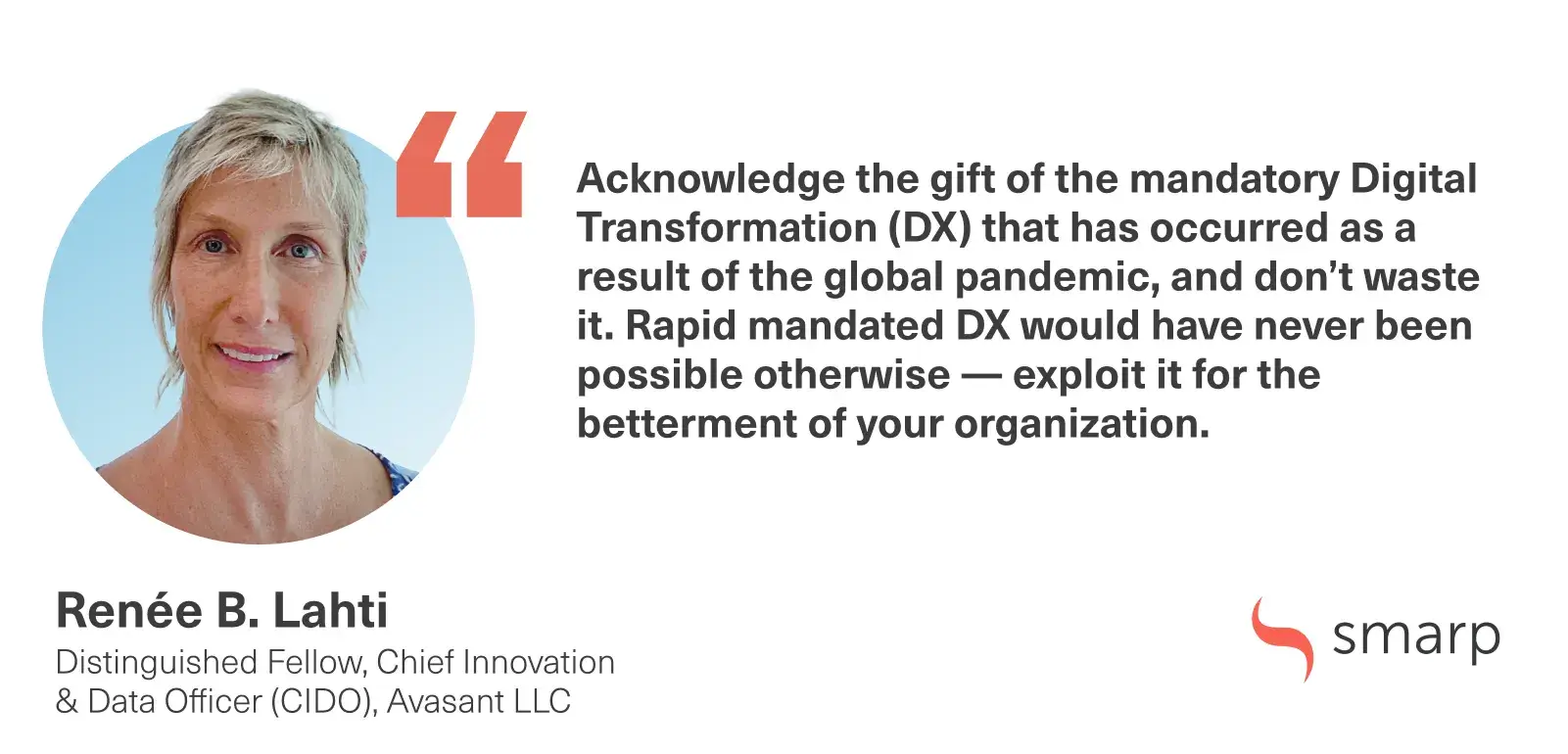
Bill Briggs, global CTO with Deloitte Consulting LLP, shares the sentiment. “Necessity has broken down some of the conventional wisdom about what is possible, which may lead organizational leaders to feel less constrained by traditional budgeting and implementation cycles,” says Briggs. “A lot of investments in foundational technology were at the heart of the initial COVID-19 response and recovery, but discussions about the core have since been elevated and expanded.”
Most recent reports by Avasant, Gartner, Harvey Nash and KPMG back up this view and outline two IT investment trends:
– The reliable way out of the crisis is through technology investment. Most companies are protecting IT/Technology budgets, reducing it only as a last resort.
– Although still single digit, many companies will be increasing IT staff in the next five years.
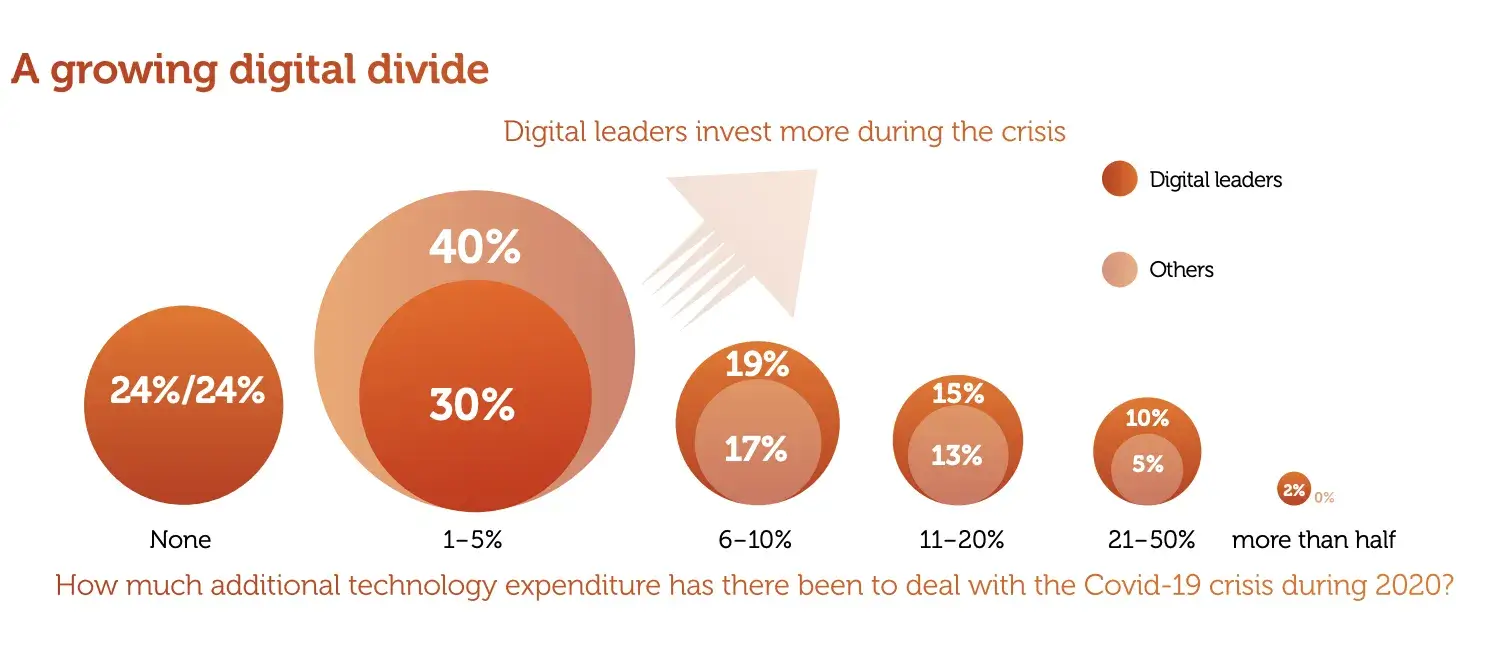
“A lot of investments in foundational technology were at the heart of the initial COVID-19 response and recovery, but discussions about the core have since been elevated and expanded,” says Bill Briggs. “More recently, some organizations are developing an appetite for spending beyond the core — a luxury most could not afford last year — and are increasingly embracing a more diverse spending mix to fuel experimentation and even risk-taking.”

Digital Transformation + Organizational Transformation
Almost half of the KPMG CIO survey respondents (47 percent) say the pandemic has permanently accelerated digital transformation and the adoption of emergent technologies. And while the post-pandemic trends for IT leaders seem to be optimistic with technology investment and adoption increase, there is a thin line between success and failure for any transformative initiative in today’s reality. How to make sure your organization is on the success side of that line?
According to McKinsey & Company, only 16% of digital transformation initiatives can ultimately be linked to quantifiable benefits to the organization that undertakes them. Joshua Siegel, Global Co-Creation Lead at Hitachi Vantara, suggests that no IT executive would (or should) bet their career investing in something with such a low chance of a positive return on investment.
“Why so many large organizations are spending so much must then mean one of two things: either they are unwilling or unable to measure their own success or a return is unnecessary,” says Siegel. “Both of these situations are unfortunate, bordering on fiscally irresponsible. Even though it may be difficult, organizations must connect transformative programs to a return and hold themselves accountable by measuring them.”
How can organizations improve their chances of generating (and tracking) a return on a large digital program? Joshua Siegel suggests two deliberate steps organizations should undertake – one preceding and the other following the digital implementation.
- Before DX program: “Organize” – Before beginning any digital transformation organizations should carefully select who participates in the effort and why. Selecting stakeholders who can embrace, fund, lead, and champion any result is critical to an ultimately successful digital exercise. Organizations should set KPIs, define ownership of both the process and output and create a ‘safe space’ organizationally for results to be embraced and ultimately implemented.
- After DX program: “Translate” – this step is critical to completing any transformation that hopes to become practically relevant in an organization. Translate involves making sure stakeholders can understand, measure, and evaluate proposed change in a way that’s relevant to them. (e.g., their personal and professional aspirations, KPIs, department’s future goals). This is purposeful measurement: not just testing a result but also proving that results can deliver what stakeholders need to be successful. Without a measurement mechanism that has broad support, change cannot be deemed a success, nor will there be institutional support for any future transformation.

McKinsey’s research shows the correlation between digital transformation programs’ success and the quality of communications supporting them. The most successful companies are much better than others at creating clear lines of communication, particularly with the frontline workforce (see the image below).
Two-thirds of respondents at these organizations say they provide regular access to information on the transformation’s progress, compared with about half of all respondents and 28 percent of those with failed transformations. Respondents at successful companies are also likelier than others to report that CEOs and senior leaders are visibly engaged and committed to the transformation.

Customer and Employee Experience
Both the Gartner study and the KPMG CIO survey highlight customer experience (CX) among top priorities for technology leaders right now (see image below). “Customer analytics is the biggest area of likely future investment,” reports Gartner. “Application leaders should adjust technology investment plans by matching them to the new customer experience priorities caused by COVID-19. As CX project priorities have shifted, so have the required supporting technologies.”
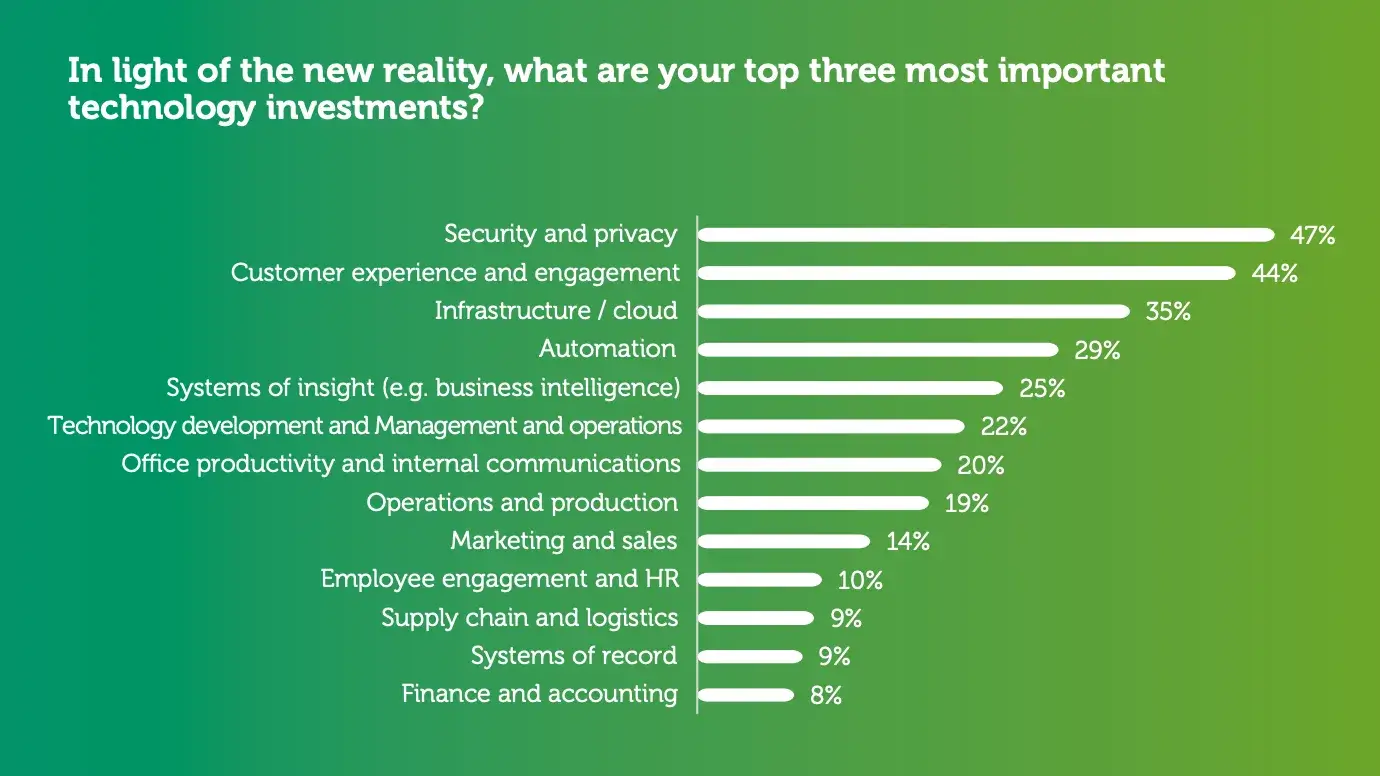
This makes perfect sense, the safety measures during the pandemic have forced businesses to rebuild their customer journeys from scratch and seek new creative ways to engage and retain customers. That said, the experience coin has two sides: customer and employee experience (EX), and the latter one seems to be undeservingly overlooked.
The COVID pandemic has launched a full-scale organizational change that is here to stay. The latest McKinsey study shows that employees have adapted to the ‘business as unusual’ and they need their leadership’s support on that new unexplored employee journey. One beautiful day the pandemic will be over, but the habits and attitudes — both customers’ and employees’ — won’t reset to 2019.
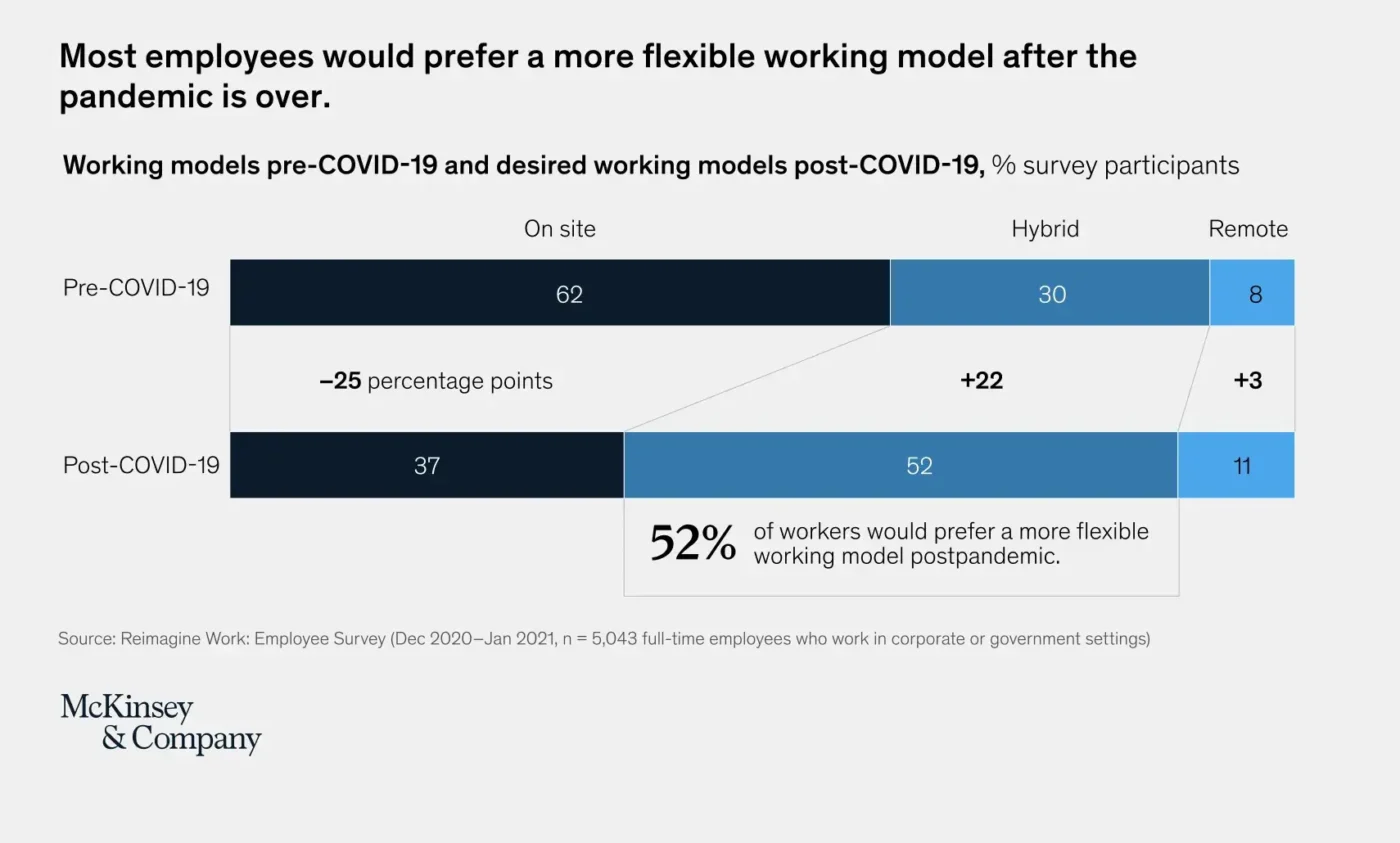
The simple truth is that without happy employees there cannot be happy customers. And IT leaders need to prioritize excellent employee experience as much as CX. Lasse Annola, VP and Partner at RND Works, says that EX is the cornerstone of a successful customer experience. “Having a transparent and engaging work environment is a top priority for us. To be able to develop digital products & services that both serve the end-users with excellent usability and inspire the team that builds them, employee experience should be top-notch,” says Annola.
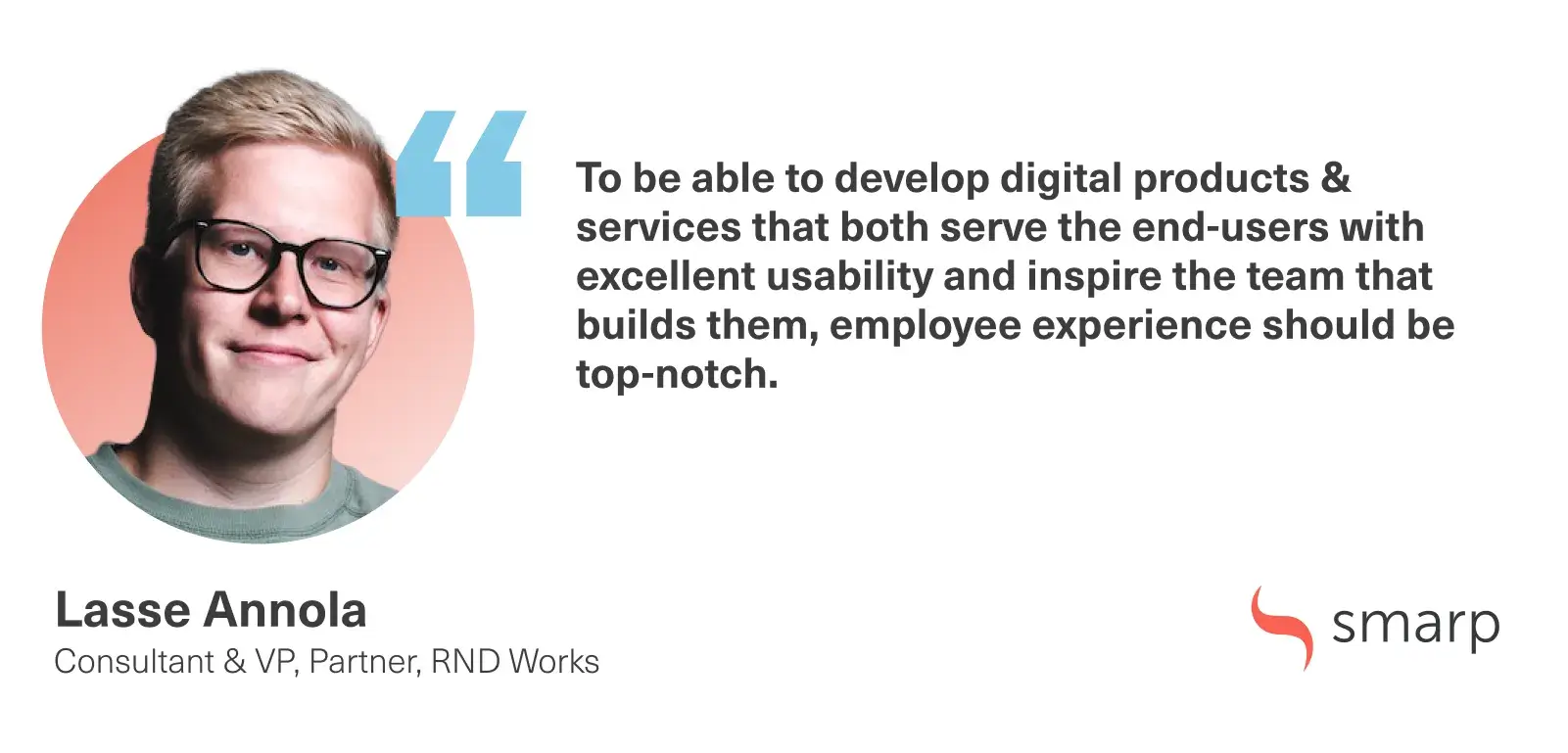
“Although our teams were always distributed, some still used to work in one space, close to each other, having an ability to quickly discuss open questions and align,” reflects Zoriana Doshna, Head of R&D Products at SoftServe. “During 2020 the alignment became one of the biggest priorities for us as leaders. Keeping the team engaged, focusing on a single goal, and making sure everyone understands where we are heading to and contributes to the teams’ success constantly.”
“On the other hand, we still focus on making our clients successful in turbulent times and continually innovating in emerging and advanced technologies. One of the main focus areas in 2021 and beyond would be Technology Commercialization in the field of Human-Computer Interaction (HCI), Edge AI and Machine Perception, Life Science and Pharma, AR Cloud, and Synthetic Data via Service Products and Offerings,” concludes Doshna.
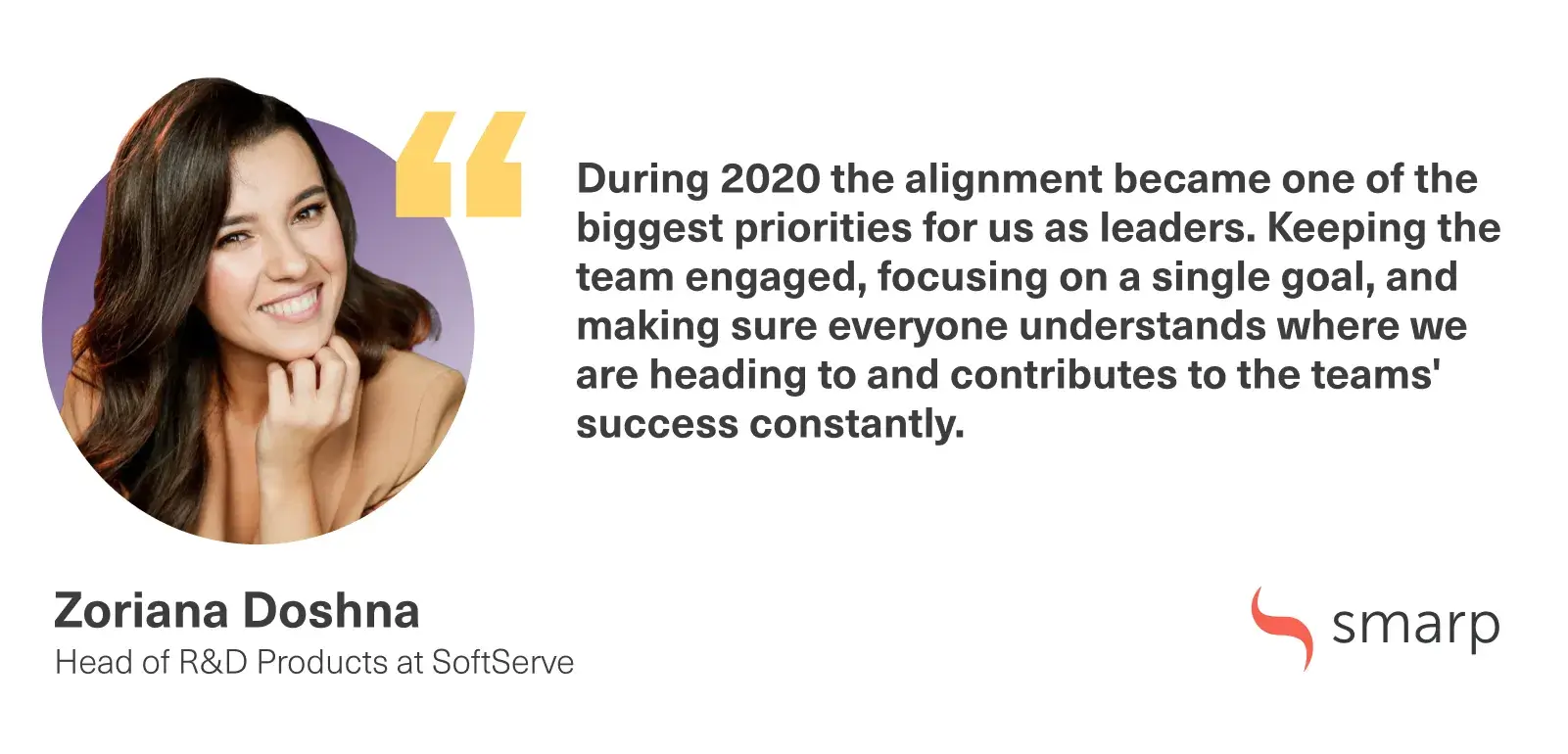
📺 Haiilo’s employee communications platform helps enterprise businesses communicate effectively with their entire workforce, corporate and frontline. Watch this short clip to learn how it works.
Data: Security, Ethics, Monetization
One part of the major EX shift that came with the pandemic was the big home office migration. No CIO or CISO could have predicted the unexpected mass relocation of office workers from the safe shores of their corporate network to private studies, bedrooms, and kitchen tables all over the world.
Data security has always been a top priority for tech leaders. With the new, more fragile remote reality, no surprise that more than four in ten IT leaders surveyed by KPMG have experienced an additional increase in cyber-security.
“There needs to be a new maniacal focus on the unknown perimeter and endpoints based on work-from-home devices (laptops, routers, etc.),” emphasizes Renée B. Lahti. “The pandemic has exaggerated the BYOD framework, which needs to be protected with policy, process, education, and investment by the organization. This takes finesse since these assets are not owned by the organization,” says Lahti.
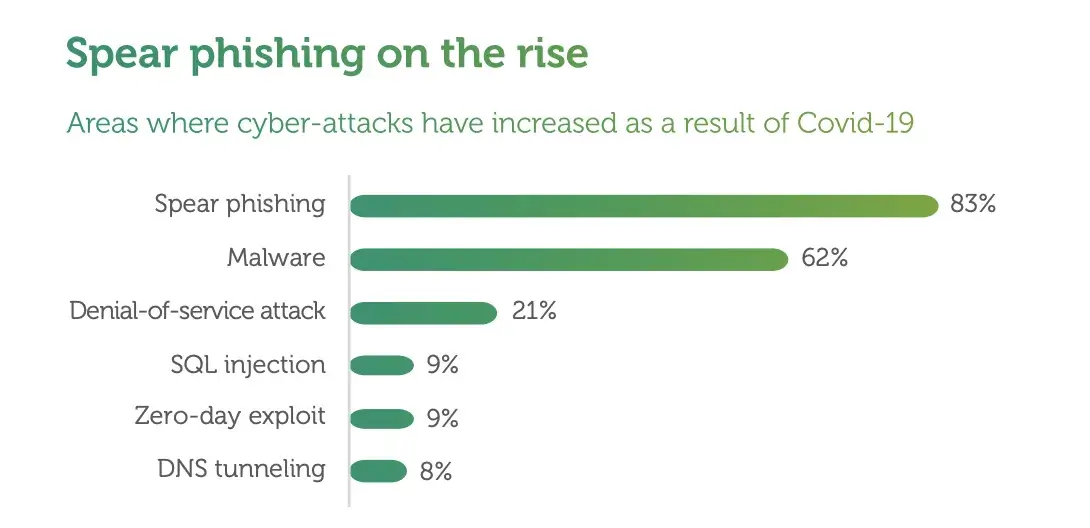
Many companies are moving from technology-centric to data-driven mindset. Moving from siloed separate data strategies to a business strategy infused with data and analytics (D&A) is the future. D&A is no longer simply about dashboards and reports, it’s about augmenting decision-making across the business.
“Data is an expanding discipline requiring more skilled workers to give it the proper attention going forward,” continues Lahti. “Technology leaders will need to virtually govern, value, and help monetize the organization’s data including composable, reusable, continuously learning and adapting AI/ML analytic modules.”
While only 17% of companies have an established data monetization initiative, that number is clearly growing. BI Survey reports that 12% of companies are currently building prototypes and an additional 10% are developing a concept. To dive deeper into the trending topic of Data Monetization conundrum, I reached out to Data Science and Data Monetization Strategic Advisor at Dean of Big Data Bill Schmarzo.
“Data Monetization charter is the guiding light in leading the organization to monetize the customer, product and operational insights buried in the organization’s data in support of the organization’s key business initiatives,” explains Schmarzo.

“Data Monetization seeks to uncover, codify, share, re-use and continuously refine the customer, product, and operational (predictive) propensities buried in the organization’s data,” he continues. “It operates and scales within a continuously-learning and adapting data and analytics environment.”
Bill Schmarzo lists six steps IT needs to take in order to succeed with Data Monetization:
- Understand the organization’s analytics maturity with respect to leveraging data and analytics to power their business and operational models
- Envision where and how data and analytics can support the organization’s key business initiatives over the next 9 – 12 months
- Collaborate with key business stakeholders to identify and prioritize the KPI’s against which the progress and success will be measured
- Clear senior executive sponsorship to remove organizational hurdles
- Sufficient, dedicated budget
- Finally, the organization needs a Chief Data Monetization Officer who has the mandate, responsibility and authority to drive cross-organizational co-creation in order to develop, share, reuse and continuously-refine the organization’s data and analytics assets.
As data analytics and monetization is continuing to mature, the top priority and the ultimate objective for IT leaders should be ethical, transparent and accountable applications of data. Advancement of big data, machine learning and AI technologies will expose technology leaders to even more dilemmas interlaced with ethical concerns. Digital leaders must pay careful attention to increased customer concerns about privacy protections related to sensitive data. The EU General Data Protection Regulation (GDPR), implemented in 2019, is a significant expression of this concern.
“We need to find the balance between increasingly prolific digitization and ethics,” emphasises Chief Digital Officer & Transformation Director Nathan Marsh. “As AI helps software offer more choices for us, we have to ensure the underlying code is free from bias and does not steer the system or network’s user interface to offer choices that can discriminate or restrict inclusion from, say, accessing a service or access to national infrastructure. This helps us drive social value and inclusive growth from the delivery and use of national infrastructure,” says Marsh.

Accelerate Digital Transformation in Your Company With Haiilo
Organizations across the world are relying on Haiilo to provide a better employee experience and create an intuitive digital workplace for every worker. Haiilo is designed to keep employees informed with the right content and make the entire workplace more engaged.
It enables better team collaboration and eliminated organizational silos that many remote and hybrid workplaces face. Empowered by AI, Haiilo makes internal communications departments more efficient and it empowers them to help employees be more productive.
The ease of implementation makes Haiilo the go-to solution for companies in search of modern workplace communications technology.
Final Notes
In the past decade, digital transformation has become a priority for many organizations, and now is the time to embrace it. Information technology executives had to rapidly react to the global crisis to ensure business continuity last year. Today we have the chance to reflect on the crisis, learn from our mistakes and adopt the right decisions that we made.
“After pulling off what most considered the impossible, IT is now turning its eyes from the triage and stabilization of the disrupted enterprise towards recovery and enabling a new reality,” reflects Steve Bates, Global Lead, KPMG CIO Center of Excellence. “In what promises to be a much more economically challenged, but digitally connected world, the CIO is facing a dilemma of how to deliver digitally native capabilities, while containing costs, skilling up and running lean,” says Bates.
With the continuing development of cutting-edge technologies, acceleration of machine learning, AI, big data analysis and monetization capabilities, tech leaders need to embrace the human-centered approach to their policies. That means further enhancing customer and employee experience and ensuring transparent and ethical data processing.
P.S. I want to personally thank all the contributors for sharing their valuable insights for this publication. Every expert featured in this post offered a unique and valuable angle on the IT field as it is today. It’s a pleasure to learn from you and support knowledge sharing in the IT community. 🙌
Lastly, if you want to learn more about how you can improve the employee experience by consolidating your tech stack around one powerful and secure employee communication platform ⏤ let’s connect. 😉









